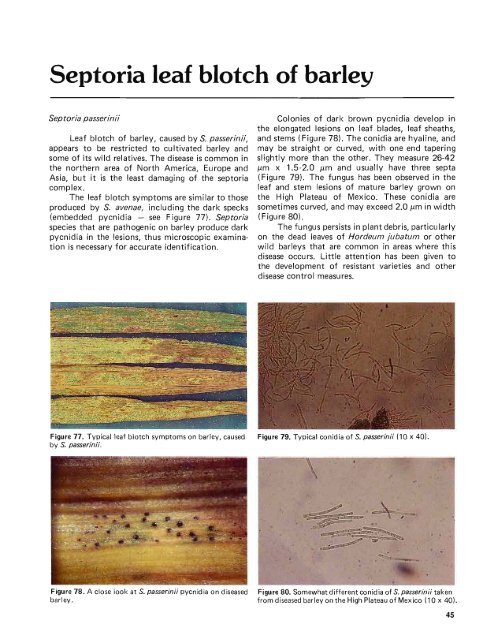Distinguishing the species - CIMMYT
Distinguishing the species - CIMMYT
Distinguishing the species - CIMMYT
You also want an ePaper? Increase the reach of your titles
YUMPU automatically turns print PDFs into web optimized ePapers that Google loves.
Septoria leaf blotch of barley<br />
Septaria passerinii<br />
Leaf blotch of barley, caused by S. passerinii,<br />
appears to be restricted to cultivated barley and<br />
some of its wild relatives. The disease is common in<br />
<strong>the</strong> nor<strong>the</strong>rn area of North America, Eu rope and<br />
Asia, but it is <strong>the</strong> least damaging of <strong>the</strong> septoria<br />
complex.<br />
The leaf blotch symptoms are similar to those<br />
produced by S. avenae, including <strong>the</strong> dark specks<br />
(embedded pycnidia - see Figure 77). Septaria<br />
<strong>species</strong> that are pathogenic on barley produce dark<br />
pycnidia in <strong>the</strong> lesions, thus microscopic examination<br />
is necessary for accurate identification.<br />
Figure 77. Typical leaf blotch symptoms on barley, caused<br />
by S. passerinii.<br />
Colonies of dark brown pycnidia develop in<br />
<strong>the</strong> elongated lesions on leaf blades, leaf sheaths,<br />
and stems (Figure 78). The conidia are hyaline, and<br />
may be straight or curved, with one end tapering<br />
slightly more than <strong>the</strong> o<strong>the</strong>r. They measure 26-42<br />
11m x 1.5-2.0 11m and usually have three septa<br />
(Figure 79). The fungus has been observed in <strong>the</strong><br />
leaf and stem lesions of mature barley grown on<br />
<strong>the</strong> High Plateau of Mexico. These conidia are<br />
sometimes curved, and may exceed 2.0 11m in width<br />
(Figure 80).<br />
The fungus persists in plant debris, particularly<br />
on <strong>the</strong> dead leaves of Hordeum jubatum or o<strong>the</strong>r<br />
wild barleys that are common in areas where this<br />
disease occurs. Little attention has been given to<br />
<strong>the</strong> development of resistant varieties and o<strong>the</strong>r<br />
disease control measures.<br />
Figure 79. Typical conidia of S. passerinii (10 x 40).<br />
Figure 78. A close look at S. passerinii pycnidia on diseased Figure 80. Somewhat different conid ia of S. passerinii taken<br />
barley. from diseased barley on <strong>the</strong> High Plateau of Mexico (10 x 40).<br />
45

















